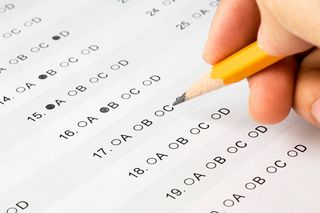
Psychometric Tests In Schools Are Not an Effective Way to Measure Ability
High school aptitude tests are fraught and one-dimensional.

While most education systems are full of academic tests that measure a child’s prowess in particular subjects, psychometric tests have been gaining popularity and are being offered to high school students. These tests are designed to measure individual differences such as abilities, attitudes, personality traits and educational achievements, according to Personality: The Psychometric View by Paul Kline. Even though they enjoy wide usage and acceptance in psychology and are used in schools, military recruitment, mental health clinics and corporates, and are considered valid and reliable, they cannot be used in isolation. Since the scores can be open to subjective interpretation, and testing parameters, such as culture, environment and the like, cannot be replicated, these tests may not always be accurate.
At the beginning of my career as an educational psychologist, approximately 15 years ago, I was trained to administer school-related psychometric tests. Over the years I saw parents placing a lot of importance on the results of these tests, but there are compelling reasons why we should think twice about relying entirely on psychometric testing.
As these tests either measure scores in relation to the results of other test takers or measure performances on how well test takers meet predetermined criteria, they cannot be used in isolation to determine the academic characteristics of individual students; they give only a one-dimensional view of the test taker. Through these tests, we might get to know a little about a lot of people, however, without spending enough time with the student and their family to understand their unique background, we cannot gauge each individual student’s capabilities. An over-reliance on psychometric testing can be detrimental, particularly when it comes to diversity and inclusion, as stated in an article in HR Magazine, where the author speaks with Aisling McDonnell, HR manager at Version 1, an Information Technology and Services company.
Related on The Swaddle:
A Year of School Measurably Changes Kids’ IQ
A popular IQ test nowadays is the Stanford-Binet test. With roots in the 19th century, this test is used to measure the intelligence quotient of an individual. Some other equally popular tests are the High School Personality Questionnaire, which is used to measure a child’s personality traits, and the Myers-Briggs Type Indicator, another personality assessment. Besides IQ and personality, other traits such as interests and aptitude are also measured by using tests such as the Strong Interest Inventory and the Differential Aptitude Test, respectively.
When talking about the use of these tests specifically in India, one has to acknowledge that while the concept of psychology has existed since ancient times, academic psychology and subsequently psychometric tests, were first introduced during the British colonial rule. These tests were largely the adapted versions of the British tests, and as such, their validity and reliability standards were based on an international experiment group.
Also, cultural factors, such as educational differences between British and Indian students, and the vocational interests between these students, weren’t taken into consideration. Post independence, psychologists started adapting some of these tests into Indian languages, in addition to developing new tests. However, the quality of these tests was questionable due to the lack of available information regarding the parameters under which they were considered valid. Even though there has been a marked improvement since the early 90s, with more than 60 percent of the tests being considered valid, and new tests being developed, they still face some problems.
Psychometric tests are offered to high school students in the hope that it will help the student and their family identify strengths and subsequently shed some light on their career options. However, since most of these tests do not fit into the Indian career context exclusively, they often end up providing superficial information to the test taker, for example, “strong math proficiency” or “good verbal skills”. They do not help in clearing the confusion and doubts, rather compounding them. The data that a school collects by virtue of these tests is then discarded rather than being used to study the gaps that may exist in the teaching versus learning styles of the cohort.
Related on The Swaddle:
Artificial Intelligence in Education: What Does Future Learning Look Like?
It is important to acknowledge that it is hard for a single test to point out the nuances of an Indian student, because of a large and very diverse student body with varying (amongst other things) socioeconomic statuses. There are also different learning styles across the myriad of curricula available. So, while the National Council for Educational Research and Training (NCERT) is developing a test to help students decide what stream they should specialise in, we may not be able to administer this test to the other students across that region, who do not study in NCERT-affiliated regional institutes. This makes us realize that while there are efforts being made to design tests targeted specifically at the subcontinent, the above-mentioned problems are hard to overcome.
Another point to note, which is true for all tests, is that testing in schools can sometimes be entirely reliant on the test administrator. This gives rise to the possibility of bias that can permeate the testing process, with regards to its interpretation and analysis, giving a skewed view of the actual results.
To illustrate this further, when I was 18, I took my first battery of six tests aimed to measure various traits. My personality test indicated that I had an extrovert personality; my aptitude seemed to be highly developed in the languages; my IQ fell in the above average range; and I also had a high score in law studies as per my interest inventory. Some of these points I was already aware of thanks to my teachers communicating the same to me, but all that the test administrator did was draw up a list of 21 possible career outcomes for me, psychology being one of them, and that was it. No sessions thereafter to acquaint me with my strengths and help me build a roadmap or give me information about how to go about studying law, which they highlighted was my strongest interest. Maybe, the pursuit of law would have led to a successful outcome as well, but my decision to pursue psychology, and not law, was made in isolation and without any information of what the study of either subject entailed.
The results of psychometric tests represent only one aspect of a person and should not be considered as gospel truth. Administrators need to ensure that the results are conveyed in a customised fashion, and then followed up with one or more counselling sessions. This holistic approach is what schools should be investing in, as it will help students make better decisions about their future. After all, the human touch trumps a test every single time.
Tripti Singh is an educational psychologist and postgraduate services manager with The Red Pen. She holds an MA in counselling psychology from the University of Mumbai, and a BA in psychology from Sophia College. Tripti has over a decade of counselling experience, helping students with their applications for graduate studies to universities in the United States, United Kingdom, Canada and Australia. Tripti lives in Mumbai with her husband and two sons.
Related


Is This Normal? “I Can’t Stop Imagining Potential Catastrophes During Everyday Situations”
